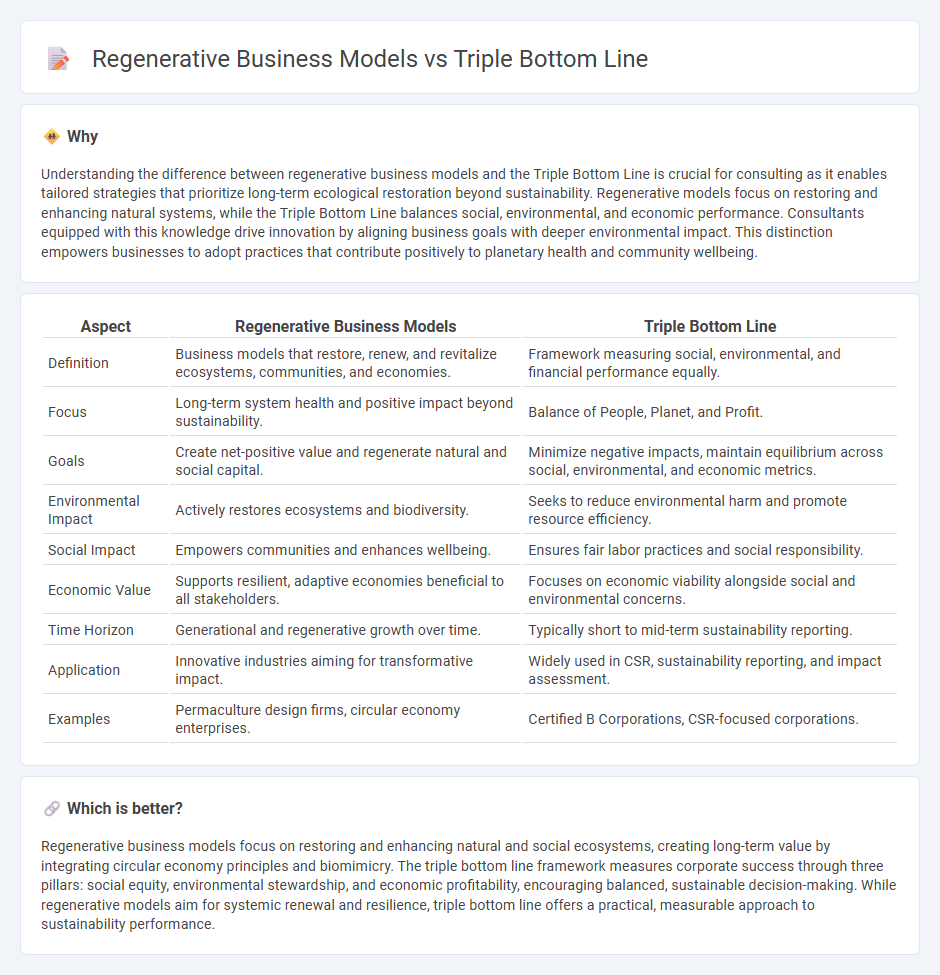
Regenerative business models focus on creating restorative and sustainable systems that regenerate resources and enhance ecosystem health, going beyond the traditional framework of the Triple Bottom Line, which measures social, environmental, and economic impacts. These models prioritize circular economy principles, biomimicry, and systemic innovation to drive long-term resilience and value creation. Discover how adopting regenerative strategies can reshape your organization's future and contribute to a thriving planet.
Why it is important
Understanding the difference between regenerative business models and the Triple Bottom Line is crucial for consulting as it enables tailored strategies that prioritize long-term ecological restoration beyond sustainability. Regenerative models focus on restoring and enhancing natural systems, while the Triple Bottom Line balances social, environmental, and economic performance. Consultants equipped with this knowledge drive innovation by aligning business goals with deeper environmental impact. This distinction empowers businesses to adopt practices that contribute positively to planetary health and community wellbeing.
Comparison Table
| Aspect | Regenerative Business Models | Triple Bottom Line |
|---|---|---|
| Definition | Business models that restore, renew, and revitalize ecosystems, communities, and economies. | Framework measuring social, environmental, and financial performance equally. |
| Focus | Long-term system health and positive impact beyond sustainability. | Balance of People, Planet, and Profit. |
| Goals | Create net-positive value and regenerate natural and social capital. | Minimize negative impacts, maintain equilibrium across social, environmental, and economic metrics. |
| Environmental Impact | Actively restores ecosystems and biodiversity. | Seeks to reduce environmental harm and promote resource efficiency. |
| Social Impact | Empowers communities and enhances wellbeing. | Ensures fair labor practices and social responsibility. |
| Economic Value | Supports resilient, adaptive economies beneficial to all stakeholders. | Focuses on economic viability alongside social and environmental concerns. |
| Time Horizon | Generational and regenerative growth over time. | Typically short to mid-term sustainability reporting. |
| Application | Innovative industries aiming for transformative impact. | Widely used in CSR, sustainability reporting, and impact assessment. |
| Examples | Permaculture design firms, circular economy enterprises. | Certified B Corporations, CSR-focused corporations. |
Which is better?
Regenerative business models focus on restoring and enhancing natural and social ecosystems, creating long-term value by integrating circular economy principles and biomimicry. The triple bottom line framework measures corporate success through three pillars: social equity, environmental stewardship, and economic profitability, encouraging balanced, sustainable decision-making. While regenerative models aim for systemic renewal and resilience, triple bottom line offers a practical, measurable approach to sustainability performance.
Connection
Regenerative business models prioritize environmental health, social equity, and economic viability, aligning closely with the Triple Bottom Line framework that measures success through people, planet, and profit. By integrating regenerative practices, companies can enhance sustainability outcomes while driving long-term value for stakeholders. This connection fosters resilience and innovation, positioning businesses to thrive in a resource-constrained economy.
Key Terms
Sustainability
The triple bottom line framework emphasizes balancing economic, environmental, and social performance to achieve sustainability. Regenerative business models go beyond sustainability by actively restoring ecosystems and enhancing community well-being through circular practices and innovation. Explore how adopting regenerative strategies can revolutionize your approach to sustainable business growth.
Value Creation
Triple bottom line models measure value through social, environmental, and financial performance metrics, emphasizing sustainability and accountability. Regenerative business models go beyond by actively restoring and enhancing natural and social systems, aiming for net-positive impacts that create long-term value. Explore how these frameworks redefine value creation and drive transformative change in business strategies.
Circular Economy
The triple bottom line framework emphasizes balancing social, environmental, and economic impacts, while regenerative business models prioritize restoring ecosystems and enhancing resource cycles within the Circular Economy. Circular Economy strategies involve designing out waste, keeping products and materials in use, and regenerating natural systems to achieve long-term sustainability. Explore how shifting from traditional triple bottom line approaches to regenerative models can transform business resilience and environmental stewardship.
Source and External Links
What Is the Triple Bottom Line (TBL)? - IBM - The triple bottom line (TBL) is a sustainability framework focusing on maximizing three P's: people (social impact), planet (environmental impact), and profit (financial performance), promoting accountability to all stakeholders and integrating sustainable practices across business operations.
Why You Should Pay Attention to the Triple Bottom Line - The triple bottom line expands traditional business success measurement by including profit, people, and planet, emphasizing a balance between financial outcomes and social and environmental sustainability as coined by John Elkington in the 1990s.
Triple bottom line - Wikipedia - The triple bottom line is an accounting framework with three parts--social equity (people), environmental/ecological (planet), and economic (profit)--aimed at ensuring fair labor practices, community benefit, and minimizing environmental harm while achieving financial viability.
 dowidth.com
dowidth.com